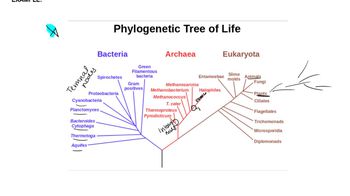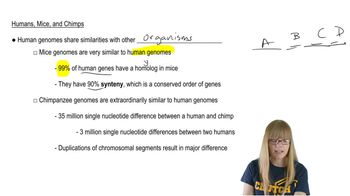Table of contents
- 1. Introduction to Genetics51m
- 2. Mendel's Laws of Inheritance3h 37m
- 3. Extensions to Mendelian Inheritance2h 41m
- 4. Genetic Mapping and Linkage2h 28m
- 5. Genetics of Bacteria and Viruses1h 21m
- 6. Chromosomal Variation1h 48m
- 7. DNA and Chromosome Structure56m
- 8. DNA Replication1h 10m
- 9. Mitosis and Meiosis1h 34m
- 10. Transcription1h 0m
- 11. Translation58m
- 12. Gene Regulation in Prokaryotes1h 19m
- 13. Gene Regulation in Eukaryotes44m
- 14. Genetic Control of Development44m
- 15. Genomes and Genomics1h 50m
- 16. Transposable Elements47m
- 17. Mutation, Repair, and Recombination1h 6m
- 18. Molecular Genetic Tools19m
- 19. Cancer Genetics29m
- 20. Quantitative Genetics1h 26m
- 21. Population Genetics50m
- 22. Evolutionary Genetics29m
15. Genomes and Genomics
Comparative Genomics
Problem 4
Textbook Question
The genetic difference between two Drosophila species, D. heteroneura and D. silvestris, as measured by nucleotide diversity, is about 1.8 percent. The difference between chimpanzees (Pan troglodytes) and humans (H. sapiens) is about the same, yet the latter species is classified in a different genera. In your opinion, is this valid? Explain why.
 Verified step by step guidance
Verified step by step guidance1
<span>Step 1: Understand the concept of nucleotide diversity, which measures the genetic variation within a population or between species. It is often expressed as a percentage, indicating the proportion of nucleotide differences between two DNA sequences.</span>
<span>Step 2: Recognize that the genetic difference between D. heteroneura and D. silvestris is about 1.8%, similar to the genetic difference between chimpanzees and humans. This suggests a comparable level of genetic divergence between these pairs of species.</span>
<span>Step 3: Consider the criteria used for classifying species into genera. Taxonomic classification is based on a combination of genetic, morphological, ecological, and behavioral factors, not solely on genetic differences.</span>
<span>Step 4: Reflect on the evolutionary history and morphological differences between chimpanzees and humans, which are significant enough to warrant classification into separate genera, despite the similar level of nucleotide diversity.</span>
<span>Step 5: Conclude that while nucleotide diversity provides valuable insights into genetic differences, taxonomic classification involves a broader set of criteria, justifying the placement of chimpanzees and humans in different genera.</span>
Recommended similar problem, with video answer:
 Verified Solution
Verified SolutionThis video solution was recommended by our tutors as helpful for the problem above
Video duration:
21sPlay a video:
Was this helpful?
Key Concepts
Here are the essential concepts you must grasp in order to answer the question correctly.
Nucleotide Diversity
Nucleotide diversity refers to the measure of genetic variation within a population, calculated as the average number of nucleotide differences per site between two DNA sequences. It is a key indicator of genetic health and evolutionary potential, as higher diversity often correlates with a greater ability to adapt to environmental changes.
Recommended video:
Guided course

mRNA Processing
Species Classification
Species classification is the systematic categorization of organisms based on shared characteristics and evolutionary relationships. The Linnaean system organizes life into hierarchical categories, including domain, kingdom, phylum, class, order, family, genus, and species, which helps scientists communicate about biodiversity and evolutionary history.
Recommended video:
Guided course

Phylogenetic Trees
Genetic vs. Phenotypic Differences
Genetic differences, such as nucleotide diversity, may not always correlate with phenotypic differences, which are the observable traits of an organism. While two species can exhibit similar genetic divergence, their classification may depend on various factors, including reproductive isolation and ecological niches, leading to different taxonomic placements despite similar genetic metrics.
Recommended video:
Guided course

Mutations and Phenotypes
Related Videos
Related Practice





